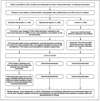The Iowa Continuity of Care study: Background and methods
- PMID: 18714110
- PMCID: PMC2859676
- DOI: 10.2146/ajhp070600
The Iowa Continuity of Care study: Background and methods
Abstract
Purpose: The background and methods of an ongoing study to determine the effects of hospital pharmacists' enhanced communication with patients and their community providers are described.
Summary: The Iowa Continuity of Care study is a randomized, prospective trial enrolling 1000 patients with selected medical conditions admitted to one large Midwest hospital. Patients will be randomized to a control group (usual care), minimal intervention, or enhanced intervention. For the intervention groups, a pharmacist case manager (PCM) will provide admission medication verification with the patients' community pharmacists, medication teaching, and discharge counseling. Patients in the enhanced intervention group will have a discharge care plan faxed to their outpatient physician and community pharmacist and will receive a follow-up phone call from the PCM three to five days after discharge; the PCM will continue to facilitate communication between the patient and community providers until all medication problems are resolved. A blinded research nurse will collect data, including adverse drug event (ADE) data, at admission and 30 and 90 days after discharge. The primary outcome measures include medication appropriateness, ADEs, emergency department visits, unscheduled office visits, and rehospitalizations. Data will be collected from the inpatient electronic medical record, outpatient physician medical records, and community pharmacist records and directly from patients. A cost-effectiveness analysis will be performed.
Conclusion: This study will address the value of a PCM in improving communication of care plans between the inpatient and community settings and thereby optimizing medication use.
Figures
References
-
- Gurwitz JH, Field TS, Harrold LR, et al. Incidence and preventability of adverse drug events among older persons in the ambulatory setting. JAMA. 2003 Mar 5;289(9):1107–1116. - PubMed
-
- Forster AJ, Murff HJ, Peterson JF, Gandhi TK, Bates DW. The incidence and severity of adverse events affecting patients after discharge from the hospital. Ann Intern Med. 2003 Feb 4;138(3):161–167. - PubMed
-
- Himmel W, Tabache M, Kochen MM. What happens to long-term medication when general practice patients are referred to hospital. Eur J Clin Pharmacol. 1996;21:178–181. - PubMed
-
- Beers M, Sliwkowski J, Brooks J. Compliance with medication orders among elderly after hospital discharge. Hosp Formul. 1992;27:720–724. - PubMed
-
- The Joint Commission. National Patient Safety Goals Manual. 2008. Available at http://www.jointcommission.org/NR/rdonlyres/82B717D8-B16A-4442-AD00- CE3....
Publication types
MeSH terms
Grants and funding
LinkOut - more resources
Full Text Sources
Medical
Miscellaneous


